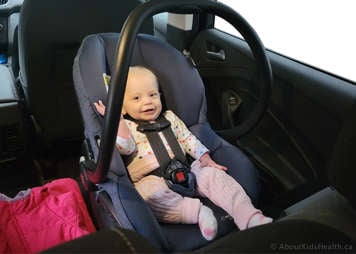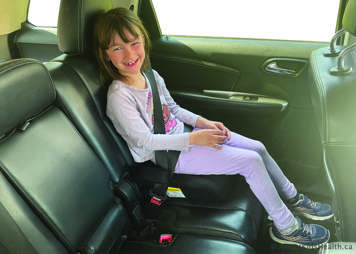How to choose the right car seat for your infant or child
In Ontario, whether your child sits in a rear- or forward-facing car seat or a booster seat depends on the following weight, height and age minimums:
- Infants and children must be rear facing until a minimum of 10 kg (22 lbs).
- Children must use a car seat until a minimum of 18 kg (40 lbs).
- Children must use a booster seat until they are 145 cm (4 feet, 9 inches tall) OR 36 kg (80 lbs) OR 8 years old.
For car seat and booster seat legislation in other provinces and territories, please see Parachute’s Car Seat and Booster Seat Canadian Legislation Chart.
Rear-facing car seat

Infants and children must be in a rear-facing car seat from birth up to specific seat height and weight limits.
Infants MUST be rear facing until they are at least 10 kg (22 lbs) AND can walk.
A child may stay rear facing as long as they fit within their car seat's height and weight requirements.
Rear-facing car seat styles
- Rear facing only (infant/bucket seat)
- Infant/child convertible car seat
- Infant/child/booster 3-in-1 seat
Forward-facing car seat

Your child may forward face in their car seat if they weigh more than 10 kg (22 lbs) and less than 30 kg (65 lbs).
Check your car seat manual for your car seat's specific upper and lower weight limits as they differ by manufacturer.
Forward-facing car seat styles:
- Infant/child convertible car seat
- Infant/child/booster 3-in-1 seat
- Child/booster combination car seat
Booster seat

Children must be at least 18 kg (40 lbs) to ride in a booster seat, though it is best to keep your child in a harnessed car seat until they are developmentally ready for a booster seat. This means your child sits still and upright with their seatbelt in the proper position throughout the entire car ride.
In Ontario, children must ride in a booster seat until they are a minimum of 145 cm tall (4 feet, 9 inches) OR a minimum of 36 kg (80 lbs) OR a minimum of 8 years old.
Five-step seatbelt test
Each province has different legislation when it comes to booster seats and readiness to move to a regular seatbelt only. If your child meets your province's requirements for moving out of a booster seat, and you think they are developmentally ready to, use this five-step test to make sure they are safe:

- Back fully against vehicle seat
- Knees bent comfortably at the edge of the vehicle seat with feet flat on the floor
- Shoulder belt centered on collarbone
- Lap belt low, touching the thighs
- Child remains in a seated position with their seatbelt properly positioned for the entire ride
How to position your infant or child safely in a car seat
Rear facing

Headrest: Refer to manual. If not otherwise stated, make sure there is at least 1 inch (2.54 cm) of space between the top of the head and the top of the car seat.
Shoulder straps: Straps are inserted into the seat at or just BELOW the shoulders.
Chest clip: Chest clip buckled at armpit level.
Crotch strap: Refer to manual. If not otherwise stated, use the slot closest to, but not under, the infant or child.
Handle: Ensure handle is in the appropriate position for driving, as per the manual.
Recline indicator: Refer to manual for recline instructions. Recline can vary depending on whether the child is rear or forward facing and/or on the age/height/weight of the child. Recline instructions should also be posted on the side of the car seat.
Clothing: No jackets, snowpants or bulky clothing are to be worn in a car seat. A blanket can be placed on top of the straps after the child has been buckled into the seat properly.
Forward facing

Headrest: Ears must be below the top of the car seat's headrest.
Shoulder straps: Straps are inserted into the seat at or just ABOVE the shoulders.
Chest clip: Chest clip buckled at armpit level.
Crotch strap: Refer to manual. If not otherwise stated, use the slot closest to, but not under, the infant or child.
Top tether: In Canada, all MUST be tethered to the car using a top tether.
Recline indicator: Refer to manual for recline instructions. Recline can vary depending on whether the child is rear or forward facing and/or on the age/height/weight of the child. Recline instructions should also be posted on the side of the car seat.
Clothing: No jackets, snowpants or bulky clothing are to be worn in a car seat. A blanket can be placed on top of the straps after the child has been buckled into the seat properly.
Additional car seat safety tips
- Always follow the child seat manufacturer manual.
- The National Safety Mark indicates that a car seat is certified to Canadian safety standards. Car seats that do not have the Canadian National Safety Mark cannot be imported, sold or used in Canada.
- Remove your infant's or child's thick or bulky clothing. This type of clothing can negatively affect safety and strap position against their body.
- Examples of thick or bulky clothing include winter coats, bulky jackets or lots of layers.
- No after-market products (products that did not come with the car seat) should be used with the car seat as they may result in safety issues or become projectiles in the event of a crash.
- Examples of after-market products include pillows or positioning inserts that do not come with the car seat, car seat covers, mirrors and toys or soother clips strapped to the car seat. Soother clips may be used if attached to the infant's or child's clothing.
- Use either UAS (Universal Anchorage System) clips OR a seatbelt to attach the car seat to the car. Do NOT use both (unless clearly specified in your manual).
- Car seats sold in Canada have expiry dates. A manufacture or expiry date is printed directly onto the car seat. This information can also be found in the car seat manual.
- Do not use a car seat that has been in a collision, even a minor one. If you have questions about use after a minor collision, contact the car seat manufacturer for details.